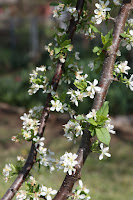Save Native Bees - Plant Flowering Trees
 The push to plant milkweed in home gardens to save Monarch Butterflies from extinction is working. Now it’s time to focus on saving bees.
The push to plant milkweed in home gardens to save Monarch Butterflies from extinction is working. Now it’s time to focus on saving bees.
The flowers on native trees play a big role in providing food and habitat for endangered native bees. This cool weather is the best time to plant trees.
These are some bee-favorites -
American Basswood, Tilia Americana, is native in the US from New England through Northeast Oklahoma and South Carolina. Basswood likes humid summers, cold winters and 20-40 inches of rain annually. The edible flowers produce high quality honey. Related to Rose of Sharon, Linden and Mallow.
Southern Magnolia, Magnolia grand flora, and Sweetbay Magnolia, Magnolia virginiana, are native from MA through OK and TX, especially in wet areas and swamps. These full sun to part-shade trees flower early summer. They mature at 30 to 50 feet tall with a 20 foot spread.
Cherry and Plum, Prunus species (Chokecherry, Prunus virginiana, Black cherry, Prunus serotina) are native here and make excellent hedges for pollinators and wildlife. Fairly easy to grow in full sun and loaded with flowers Also, the caterpillars of Red Spotted Purple, Hairstreak and Tiger Swallowtail eat the leaves. These trees colonize so allow plenty of room for them to spread.
Native Redbud, Cercis species, is commonly seen on shady, wet, hillsides and along forest edges. The spring flowers give bees some early pollen. Cercis Canadensis var texensis Oklahoma is an eastern Redbud bred for hotter climates. Sun to part-shade.
Serviceberry, Amelanchier, is an early-season pollen source for bees. In the summer the berries can be harvested for jam or left for wildlife food. Matures at 15-feet, has red leaves in the fall, needs no spraying.
Tulip Poplar, Liriodendron tulipifera, a significant source of nectar for bees. Matures at 60-90-feet. Prefers moist, well-drained soil and full-sun. Showy flowers, good shade tree, tolerates deer, clay soil and black walnut tree roots.
Visit the Xerces Society for Invertebrate Conservation (https://xerces.org) to learn more.




Comments